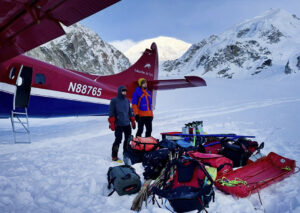It’s tough for a climber to catch the southwest face of Alaska’s Mount Abercrombie at just the right moment. The broad, snow-banded face rears up from its low-altitude glacial footings near Valdez, Alaska. Vertical relief is more than a mile. Tantalizing ascents are guaranteed, you’d think.
But usually, Mt. Abercrombie hides under blankets of snow thick enough to suffocate progress. When it finally melts for the year, it happens fast. You don’t have to be a rocket scientist to guess what happens to a giant, reflective, south-facing shield of ice and snow once the sun starts to beat down.

“Thin” coverage on “Moonlight Mile” (marked). Photo: Frez-Albrecht
That’s a big reason local climber August Franzen and his partner, Simon Frez-Albrecht, spent three years waiting for the mountain to come into climbing condition. But when it did, they pounced — and authored just the second ascent of the wall.
Moonlight Mile charges the southwest face of Mt. Abercrombie at WI4+ (and merited an R rating under the conditions they found, Frez-Albrecht said). The team chose a night in late March to race up the wall, climbing all night, summiting, then walking off in around 14 hours.
In a phone interview, Frez-Albrecht painted a picture of diligent progress with few snags.
“Usually, climbs like this are all about ‘What went wrong?’” Frez-Albrecht, a mountain guide at Talkeetna’s Alaska Mountaineering School, said. “I couldn’t believe how smooth it all went.”
It’s hard to overstate the trapeze act of timing it takes to climb a route that’s so susceptible to melting. Colin Haley and Jed Brown claimed the only other ascent of the southwest face of Abercrombie in 2006. The lull was not for lack of attention — as Frez-Albrecht put it, it’s “in the backyard” of Valdez, which fervent ice climbers scour in search of massive frozen waterfalls. Instead, it takes a special year and a masterstroke of gauging winter climbs.
“We had one pitch that probably wouldn’t have survived another two sunny days,” Frez-Albrecht said. “It was pretty thin.”

Frez-Albrecht on the wall. Photo: Franzen
After a snow machine ride to the wall, followed by a nap, the climb went swimmingly. But near the top, it still refused to yield the easier progress the two men thought it would.
The snow band that cuts the face from left to right effectively divides it cleanly in half. Frez-Albrecht and Franzen planned on nothing but low-angle snow wallowing between it and the summit. Instead, they got stout pitches requiring belays and ice tools.
They’d already swung and kicked their way through a steady diet of ribboned water ice on the bottom half. Anybody who’s used the tools knows: They take a toll on your forearms and hands.

Frez-Albrecht on frontpoints and axe picks. Photo: Franzen
“[Initially], we thought we’d just boot up the snow couloirs to the top. But we got up there and we were like, ‘Did we go to the wrong place?’” Frez-Albrecht recalled. He paused. “We weren’t…that psyched. Speaking for myself, after that long swinging tools, my hands were pretty tired.
“But there was more technical climbing than we expected on the route, which was a nice surprise overall,” he concluded.

Photo: Frez-Albrecht
It’s possible that’s a sheer necessity of taking a direct line up the face. In their 2006 ascent, Brown and Haley accidentally jogged well to climber’s right and crested onto the north ridge sooner than they’d hoped.
All things considered, you’d better have alpine chops if you want to go repeat Moonlight Mile — and a Valdez connection.

Franzen (left) and Frez-Albrecht on top. Photo: Franzen
“It’s a total jam. And if it came into shape more often, I think it could be totally classic. But it’s just that you have to wait 15 years or whatever between ascents,” Frez-Albrecht advised. “And there’s no better pulse on conditions than if it’s your own yard and you can go look at it.”






